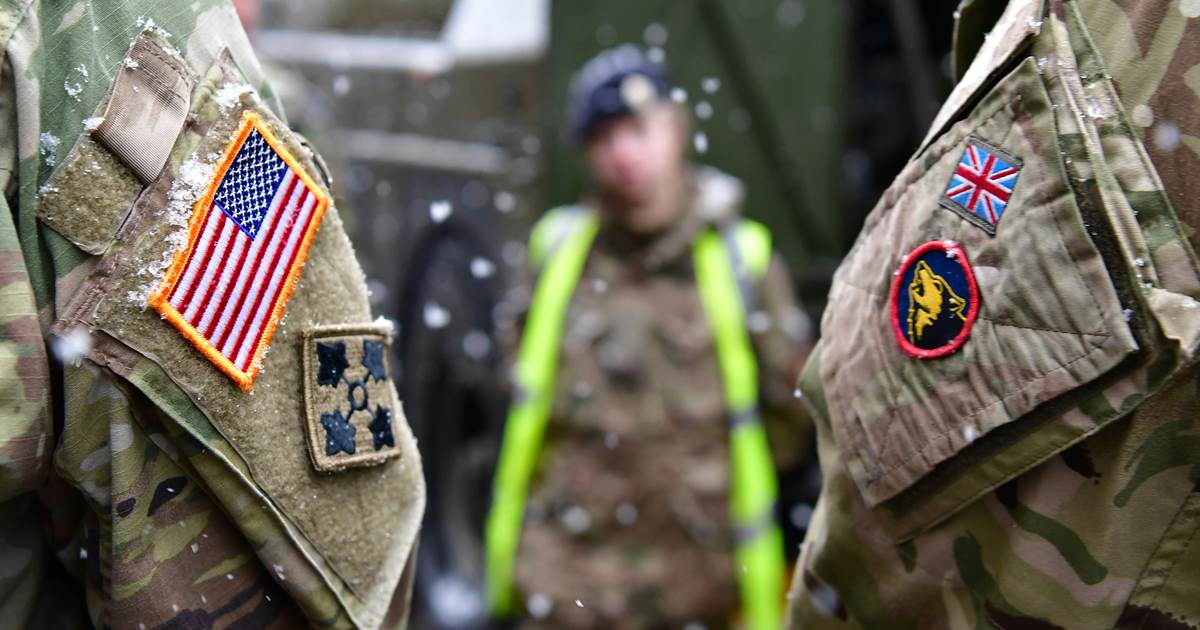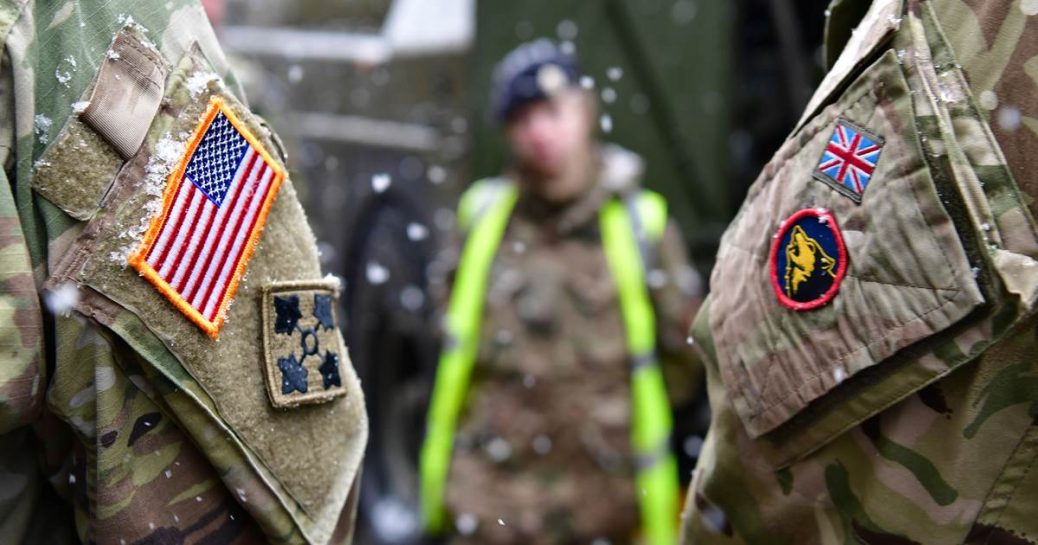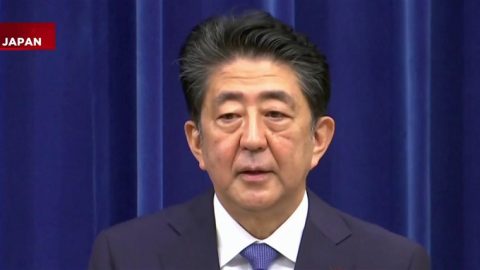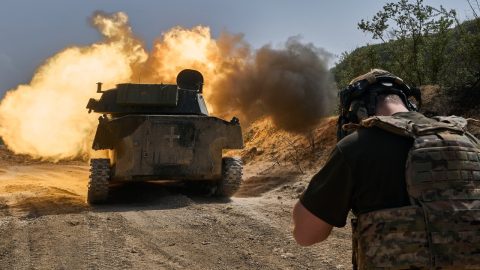
HOHENFELS, Germany — Dawn pierced the mist as Capt. Matthew Likes prepared to fend off a fierce but simulated attack on the edge of remote woodland.
When the mock assault came — real Apache helicopters thundering across the treetops and actual tanks trundling over a hill — Likes’ team, dressed like the Russian “little green men” who appeared in Crimea in 2014, responded with blank 50-caliber rounds.
The multinational exercise, involving 4,100 troops over 10 days, was concocted to rehearse the “peer-to-peer” warfare that American commanders and their allies expect to face — in the event of a conflict with a country like Russia, whose military capabilities match those of the United States.
Multiple current and former U.S. Army officers told NBC News that this 40,000-acre terrain in southern Germany is the only possible location at present to hold such extended international training, with soldiers from countries such as Ukraine, Slovenia, Romania and Italy participating. The U.S. military has invested hundreds of millions of dollars over several decades on the sprawling facilities here – one of the many reasons that multiple retired military commanders, former national security advisers and lawmakers from both parties have questioned the Trump administration’s plan to move 12,000 troops out of Germany.
The landscape in southern Germany roughly matches the rolling, lightly forested hills of eastern Ukraine, where most of the 200 Ukrainian soldiers attending the exercise had previously fought against Russian-backed separatists as recently as June.
Likes, 29, said the object was to recreate the threats American and allied forces could face, in the most up-to-date way possible.
“Whether that’s info war, whether that’s mercenary groups, whether that’s bombings — anything we can do to replicate what is actually happening in the world right now, especially here in Germany,” he said.
Former Vice President Joe Biden’s campaign said he would cancel the planned troop withdrawal if elected. And officials on both sides of the Atlantic said the future role and scope of U.S. forces in Germany may be one of the most significant foreign policy decisions to hinge on November’s presidential election.
At a September hearing of the House Armed Services Committee, retired Lt. Gen. Ben Hodges, the commander of U.S. Army forces in Europe between 2014 and 2017, appeared via video conference to say that the Pentagon’s plan to withdraw more than 12,000 soldiers and airmen from Germany was “a mistake.”
The following day, he told NBC News in Frankfurt that Germany was America’s “most important ally.” He said the “political decision” to reduce U.S. forces in the country by a third would send “a terrible signal” to Russia, which still occupies parts of Georgia and Ukraine’s Crimean peninsula, and continues its aggressive behavior on the eastern edge of Europe.
Rep. Mac Thornberry, the ranking Republican on the House Armed Services Committee, said the Trump administration must not overlook the role troops in Germany play in training NATO allies. But he also said the forces — including a sizable U.S. Air Force contingent, and several regional command headquarters — support onward transit for troops heading to the Middle East and Africa, and act as a deterrent to Russian threats.
Download the NBC News app for breaking news and politics
Retired Adm. James Stavridis, the supreme allied commander of NATO from 2009 to 2013, and now an international security analyst for NBC News, agreed, saying the withdrawal concerned him because there was “no strategic underpinning, no theory of the case.”
“I don’t see this as a done deal,” he said. “I think that there is a very significant probability that this will be reversed, certainly by a Biden administration,” and that even a second Trump term would mean Pentagon officials “will take one more look at this, as well.”
Tony Blinken, the senior foreign policy adviser for Biden’s presidential campaign, said in a written statement that the decision to withdraw troops from Germany was “ill-informed and irresponsible, and that Biden, if elected next month, would “review this decision, in coordination with our NATO allies.”
A spokesman for the Department of Defense, Lt. Col. Thomas Campbell, said the changes to force levels in Germany were designed to “enhance deterrence to counter Russia and other malign actors, strengthen NATO, reassure Allies, improve U.S. strategic flexibility and operational flexibility, and take care of our service members and their families.”
But he also echoed Secretary of Defense Mark Esper, who acknowledged in July that this plan “likely will change to some degree as it evolves over time.”
The commander in chief has at times undercut the Pentagon’s explanations. Outside the White House in late July, Trump answered a reporter’s question about the troop withdrawal in Germany by saying “We don’t want to be the suckers anymore.” He added, “We’re reducing the force because they’re not paying their bills. It’s very simple.”
NATO countries do not pay “bills” to belong to the alliance, but each member nation did commit in 2014 to ensure that their spending on defense programs grew to at least 2 percent of their national gross domestic product.
Jurgen Hardt, the foreign affairs spokesperson for German Chancellor Angela Merkel’s political party, the Christian Democratic Union, said the Trump administration’s argument that Germany is being punished with this troop withdrawal for not spending enough on its defense is “weak,” given that under the Pentagon’s published plans, so many of the troops currently in Germany are scheduled to move to Italy and Belgium, NATO members that both spend even smaller proportions of their GDP on their militaries than Germany.
He said “campaigning in the U.S,” rather than facts, was the “main driver for the decision.”
Thomas Silberhorn, another German parliamentarian and state secretary to the defense ministry, who traveled to Washington in July to discuss the withdrawal plans with members of Congress and Trump administration officials, called the U.S. troop presence the “backbone of our common security as NATO allies.” But he agreed the decision had been made primarily to influence the American electorate, and said he expected a reassessment of the move in the future.
“I don’t expect this decision to be withdrawn,” said Silberhorn who, like many, highlighted the potential billions of dollars in associated costs. “But when it comes to details, the questions become harder and harder.”
For American troops stationed here, the answers can seem easy. Germany is close to current conflict zones, and the bases here provide an opportunity to train alongside multiple military partners for months at a time that is entirely unique.
“In the States, we don’t get any of that,” infantry officer Likes said of training alongside partner nations like Ukraine. “But here, we have that whole extra element, which makes the whole thing – I think – a lot, lot better.”










Recent Comments